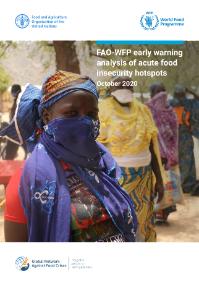FAO and WFP warn of rising levels of acute hunger with potential risk of famine in four SUN countries
Burkina Faso, northeastern Nigeria, South Sudan and Yemen cause for concern but acute hunger on the rise across the globe The world has been put on a heightened famine alert with a new report by two United Nations agencies that contains a stark warning; four…
Burkina Faso, northeastern Nigeria, South Sudan and Yemen cause for concern but acute hunger on the rise across the globe
 The world has been put on a heightened famine alert with a new report by two United Nations agencies that contains a stark warning; four countries contain areas that could soon slip into famine if conditions there undergo “any further deterioration over the coming months”. These are Burkina Faso in West Africa’s Sahel region, northeastern Nigeria, South Sudan and Yemen.
The world has been put on a heightened famine alert with a new report by two United Nations agencies that contains a stark warning; four countries contain areas that could soon slip into famine if conditions there undergo “any further deterioration over the coming months”. These are Burkina Faso in West Africa’s Sahel region, northeastern Nigeria, South Sudan and Yemen.
The Early Warning Analysis of Acute Food Insecurity Hotspots – issued today by the Food and Agriculture Organization of the UN (FAO) and the UN World Food Programme (WFP) – describes a toxic combination of conflict, economic decline, climate extremes and the COVID-19 pandemic that is driving people further into the emergency phase of food insecurity.
Parts of the population in the four hotspots of highest concern are already experiencing a critical hunger situation, with the report warning that escalations in conflict as well as a further reduction in humanitarian access could lead to a risk of famine.
But these four countries are far from being the only red flag on a world map that shows that acute food insecurity levels are reaching new highs globally, driven by a combination of factors, the report notes. Another 16 countries are at high risk of rising levels of acute hunger.
The aim of the Hotspots report is to inform urgent action that can be taken now to avoid a major emergency – or series of emergencies – in three to six months from today. How the situation evolves in the highest risk countries will depend on conflict dynamics, food prices, and the myriad impacts of the COVID-19 pandemic on their food systems, rainfall and harvest outcomes, humanitarian access, and the readiness of donors to continue funding humanitarian operations.
“This report is a clear call to urgent action,” said Dominique Burgeon, FAO’s Director of Emergencies and Resilience. “We are deeply concerned about the combined impact of several crises which are eroding people’s ability to produce and access food, leaving them more and more at risk of the most extreme hunger. We need access to these populations to ensure they have food and the means to produce food and improve their livelihoods to prevent a worst-case scenario.”
“We are at a catastrophic turning point. Once again, we face the risk of famine in four different parts of the world at the same time. When we declare a famine it means many lives have already been lost. If we wait to find that out for sure, people are already dead,” said Margot van der Velden, WFP Director of Emergencies.
“In 2011, Somalia suffered a famine that killed 260 ,000 people. The famine was declared in July, but most people had already died by May. We cannot let this happen again. We have a stark choice; urgent action today, or unconscionable loss of life tomorrow,” she warned.
FAO-WFP early warning analysis of acute food insecurity hotspots
FAO-WFP early warning analysis of acute food insecurity hotspots
October 2020. Rome.
